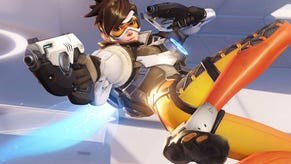Overwatch PC performance graphics guide
The chase for 60fps, and the hardware required to get the job done.
Encouraged by how Overwatch runs on a budget PC - where an i3 4130 and GTX 750 Ti is all you'll need to run at medium settings - our sights now shift to setups further along the spectrum. Blizzard's hero-based FPS demands 60fps or better by its frenetic nature, and this is the base requirement for the cards in test today. Gladly, Overwatch's low GPU demands mean just about any modern GPU can run the game at this refresh, and in the case of the popular GTX 970 or R9 390, there's loads of headroom to spare for a locked 60fps experience and beyond.
Let's take the GTX 970 as an example, where the range sits comfortably between 80 to 110fps while running all-out at 1080p and maximum settings. It's a blazing fast return on our i7-4790K machine, and it means anyone using a 60Hz refresh monitor is assured a solid, smooth experience on this card. At the same time, there's a lot of GPU processing power not being truly tapped into here, especially on displays with a fixed refresh rate of 60Hz. Fortunately those using higher refresh monitors, and also G-sync enabled panels that can adapt to this fluctuating frame-rate, will be able to enjoy the benefits of running at 80fps at minimum.
The alternative is simple enough: rather than let the GTX 970's frame-rate float far above 60fps, instead spend its excess processing power on image quality. Bumping the resolution to 1440p has an impact on these initial results, reducing frame-rates by up to 20fps across a match-up. At max settings, the GTX 970's range in performance then becomes 60 to 90fps, and it means native 1440p monitor support is very much within its means. You'll get very occasional dips below 60fps with this setup, though a small boost on the card's memory clocks (up by 400MHz) essentially smooths over its rough edges.
AMD's R9 390 handles Overwatch in a similar way. At 1080p and max settings, we record an overall range of 75fps to 105fps from the card, though it's worth stressing our tests can't be matched perfectly to those on the GTX 970, owing to the wildly different outcomes between each game. But at the very least, there is an impression of performance; with the same characters and maps, the average comes to 5fps lower on average across six minutes of gameplay. It's certainly in the same ballpark, and R9 390 owners are looking at excellent performance here if they're connected to a straight 1080p monitor
Again we have plenty of options to make better use of the R9 390's processing power, with the right monitor specs. In this case we have the option to run the frame-rate unlocked on FreeSync enabled panels, allowing for refresh rates up to 105fps at maximum settings - where typically we'll be operating at the 90fps mark. Much like the GTX 970, it's maps with a heavy use of fog and reflections, such as King's Row, that bring it down to the lower numbers on record. Even in these worst case scenarios though, the card's performance in 1080p playback is hard to fault.
Those looking to run the game at 1440p can also rejoice. In the case of the R9 390, no overclock is needed to run Overwatch at this resolution and all settings maxed out. Performance is consistently above 60fps at stock clocks this time, compared to the GTX 970 with its occasional dips, and AMD's card benefits from a wider 512-bit memory bus in pushing higher pixel counts. It's a great turnout for the card, and 1440p monitor users won't have to resort to upscaling from 1080p, or indeed a drop in settings, to play the game at a smooth frame-rate.
It's clear Overwatch is built for as wide a range of PC setups as possible. Even in testing an older R9 280X paired with an i7-3770K CPU for example, we still stick to the 65-70fps region on average at 1080p with the epic preset selected. Equally, the game runs well on current cards in the £150 bracket; the likes of the GTX 960 and R9 380 squeeze in 60fps at the very same top settings. For these two cards, it's a safer bet to drop shadow and fog settings a preset to keep performance locked at this number - a drop in visual quality that's hard to catch in play, but creates a comfortable headroom in frame-rates.
On the other end of the spectrum, we considered how a game like Overwatch might take advantage of powerhouse GPUs, such as the brand new GTX 1080. It's an extravagance, but running at 3840x2160 (or 4K) proved the easiest way to tax this card, with no other in-game settings to crank up the heat on this GPU. It's one of few modern titles where running at 4K is feasible, but a question mark still dangled over whether it could be done at maximum settings too, while still targeting that crucial 60fps.
Our first test involved downsampling from 4K to a 1080p monitor, using the Nvidia control panel's DSR option. In this case, the extra sampling process does incur a slight performance hit, but we're still locking to around 70fps during play. It gives us a healthy cushion across most maps, and notably the Anubis stage runs without a hiccup at 4K60 with all 12 heroes congesting one point. However, playing as the explosive Junkrat character in maps like Hollywood, even the GTX 1080 starts to buckle, with performance at peak load running between 50-60fps.
The results are mixed, but it's an impressive starting point for the card. Frame-rates vary based on the complexity of each map, and the simple solution is often to pare back a few choice settings - such as local fog, and likewise for shadow detail. These are small changes, but it clears the air for the GTX 1080 at peak action, and once in place, we're running at a firm 60fps even on the most taxing maps. It sets a precedent for what we hope to see from this card in future games, especially given the rising interest in native 4K panels, and content to show them off.
In truth, playing Overwatch at this resolution and 60fps is a luxury few of us can enjoy right now. 4K is also unlikely to be the highest item on the agenda for the game's competitive scene - where any GPU's processing power is likely better spent on reaching 120fps, or even 144fps on supporting monitors. For a fast-paced game in this style, a snappier refresh rate like this is a bigger advantage than a sky-high pixel count. However, it's a welcome sight to see the game running at such a crisp resolution for those who can do it, and it proves 4K is very much within this card's remit.
From the humble R7 360 and GTX 750 Ti to the excesses of the GTX 1080, it's hard to pick any real complaint with Overwatch's PC performance. It's only on older integrated graphics, such as a test of the Intel HD 4600 chipset on our i7 desktop, that we found the game struggling to run well. In that case, 60fps isn't possible even on the lowest settings, and only by dropping the resolution to 720p could we get a 30fps cap to work without a fault (the unlocked rate being 30-40fps). Laptops lacking discrete GPUs use similar technology, but TDP limits make them even less performant. This represents the other extreme end of the scale for Overwatch of course, but for anything in-between, Blizzard has you covered.
For all the latest Overwatch hero, map and gameplay guides, visit our sister site MetaBomb












